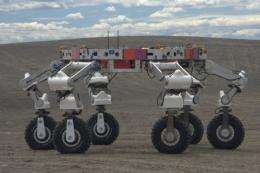Beyond Apollo: Moon Tech Takes a Giant Leap

The flight computer onboard the Lunar Excursion Module, which landed on the Moon during the Apollo program, had a whopping 4 kilobytes of RAM and a 74 KB "hard drive." In places, the craft's outer skin was as thin as two sheets of aluminum foil.
It worked well enough for Apollo. Back then, astronauts stayed on the lunar surface for only a few days at a time. But when NASA sends people back to the Moon starting around 2020, the plan will be much more ambitious — and the hardware is going to need a major upgrade.
Instead of staying for days, astronauts will be living on the Moon for months on end, and they will push the envelope of exploration farther than ever before. So NASA is developing a new generation of hardware to meet the needs of this new mission: intelligent robots, truck-sized lunar rovers with pressurized cabins, inflatable habitats, and more.
"If we want to stay on the Moon for longer, then we have to develop the equipment necessary to survive in that environment," says Frank Peri, director of NASA's Exploration Technology Development Program (ETDP).
During the Apollo era, robotic sidekicks existed only in the realm of science fiction. If astronauts needed to move some heavy equipment, they had to pick it up themselves; if they wanted to investigate a crater, they couldn't send in a robot for a first look. Semi-autonomous robots being developed by ETDP will lower risks by helping astronauts with such tasks.
A six-legged, spider-like robot called ATHLETE (short for All-Terrain Hex-Limbed Extra-Terrestrial Explorer) will handle the heavy lifting. "It's basically a big flatbed truck, so you can put things on it to move them around," Peri says. A prototype built at the NASA Jet Propulsion Laboratory has wheels on the end of each leg. That way, it can roll under the lander module, for example, lift it up, and roll it to another location -- stepping over boulders that might lie in the way. Astronauts could also replace the wheel on one or more legs with drills or other tools so that ATHLETE can help them with other maintenance or exploration tasks.
ATHLETE, along with smaller robots being developed by ETDP as scouts, will have the CPU power it takes to respond to vocal and gestural cues from the astronauts, as well as the capability to be remotely controlled from a distance. Four kilobytes of RAM will not be enough for these brainy machines.
When astronauts do venture out across the lunar surface themselves, they'll have a much better ride than the old Apollo moonbuggy. "If you've seen those videos of astronauts driving the Apollo rover on the Moon, you've seen that the ride was pretty harsh," Peri says. If that rover resembled a dune buggy, the new rover being developed by ETDP will be more like an RV. It will have an enclosed cabin complete with sleeping space so that astronauts can rest during long excursions. Bubble-shaped windows will let explorers observe the lunar surface up close without leaving the safety of the vehicle.
Sometimes, though, nothing can replace getting out and doing some hands-on exploration. Spacesuits attached to the outside of rover will make it easy for astronauts to slide directly into the suits from the comfort of the cabin -- no airlock required. And those spacesuits will be able to handle much longer exposure to abrasive lunar dust than Apollo suits could. "Those Apollo suits were practically trash by the time the three days were up," Peri says. "These new suits will have to last in that harsh environment for months or years."
When they return to base, these future lunar explorers will need a home that can provide air, water, food, and protection from harmful radiation for months. The Apollo lander's thin skin wouldn't shield enough of the radiation that pervades space to protect astronauts' health for that long. And the astronauts are going to need much larger power systems, life-support equipment, and living and working spaces to be able to fulfill their mission.
So EDTP is developing inflatable habitats that will balloon up to full size after arriving on the Moon, as well as techniques to make durable materials out of the lunar regolith (lunar soil). Surrounding the habitat with thick layers of a regolith-based material would provide excellent radiation shielding for the occupants inside.
It's all quite a tall order. But the payoff for developing these technologies now will be more than just a long-term human presence on the Moon. While the hardware required for living on the Moon for months is very different from that needed by the Apollo program, it's very similar to the hardware needed to live someplace else:
Mars.
Source: Science@NASA, by Dr. Tony Phillips
















